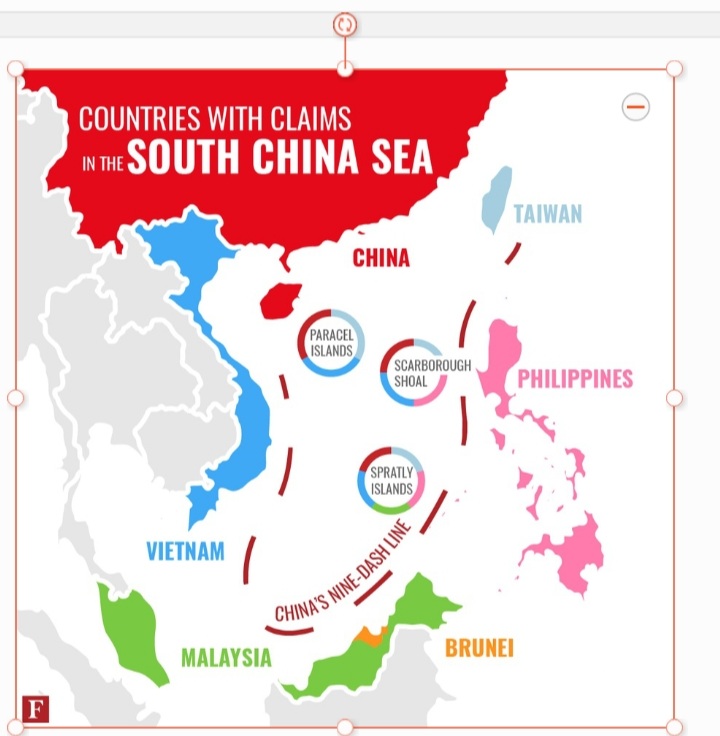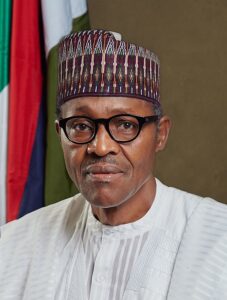
Data via the Asia Maritime Transparency Initiative; Design by Aliza Grant, Forbes Staff
By Egbodje Wilson
Rising stakes between bickering global military powers have turned the strategic South China Sea region into a flashpoint
The danger looms large as the situation gets scarier with each passing day. Stirring the combustion is the People’s Republic of China, a nation constantly on the march since perfecting its industrial revolution in the last quarter of the twentieth century. Just how long the international community can contain China remains a matter of conjecture. The situation demands compelling efforts to facilitate a global resolution of existing tensions in that sphere. This is of critical essence.
In recent times Chinese pressure on Taiwan has forced U.S President Joe Biden to shift from Washington’s decades – long policy of “strategic ambiguity” to definitive clarifications on U.S position in the troubled region. President Joe Biden in an interview granted to CBS news in Washington D.C on September 18, 2023 stated unequivocally that he would send U.S forces to defend Taiwan if invaded by China. The foreboding portends ominous implications, obviously not something to be imagined. Old realities are obfuscating alarmingly and giving vent to dangerous, previously uncontemplated possibilities. All concerned parties must accordingly have a clear understanding of the strategic geo-political essence of keeping the sea lane to the Indo-Pacific secure.
In the past five years the South China Sea has played host to some of the world’s most modern instruments of war. Day after day there’s an increasing number of naval vessels with bristling military hardware engaging in exercises alongside commercial shipping. Naval aircraft carrier groups, Cruisers, Submarines, Destroyers along with a panoply of other warships from the U.S, UK, China, Canada, France, Japan, Australia, India regularly visit to demonstrate their proficiencies, exercising their rights to Freedom of Navigation and Overflight Operations (FRONOP). New military and economic alliances are springing up to checkmate China’s growing influence in the region and beyond.
SOUTH CHINA SEA DISPUTES
South China Sea disputes are many and the region is known to be a hotbed of potential territorial conflicts. The principal actor in these disputes is the People’s Republic of China (PRC). Other disputant nations are Vietnam, Malaysia, Brunei, Taiwan and the Philippines. At the center of the storm is Beijing’s imposed Nine Dash – Line which claims ninety percent of the 3.6 million sq. km of the water body, reducing the sea shore of other disputing nations from two hundred to less than one hundred kilometers. As a follow up, other nations sharing coastline with the sea have also made legitimate claims to the strategic water way.
Consequently, the Philippines government in seeking efforts to resolve the dispute with China presented a protest letter to the International Arbitral Panel at The Hague. The Panel ruled conclusively that:
1. There is no evidence to substantiate Beijing’s claims to sole ownership of the South China Sea and all the resources in it. China’s claim to the territory allegedly since antiquity, dating back to over 2,000 years was therefore nullified. In other words the Tribunal made clear that no such evidence was available before the UN Convention on Law of The Sea (UNCLOS) was ratified in 1982. China is a signatory to the ratification.
2. That the Nine – Dash Line Arbitrarily imposed by China cannot serve as a basis for imposing maritime restrictions over the South China Sea. It stated further that: “there are high seas there which belong to all mankind, existing with exclusive economic zones that belong to adjacent coastal states”. The implication there is that the naval powers of the world can sail and fly as well as conduct naval exercises in the high seas and exclusive economic zones of the South China Sea. The freedom of navigation and overflight operations FRONOP of the U.S., U.K., France, Australia, Japan, India and Canada have restrained China from enforcing its nine-dash line as its national boundary in the South China Sea. China’s third claim is that it had sovereign rights over the area predating the 1982 UN Convention on Law of the Sea. The law states that the territorial waters of any country extends 200 miles from its coastline into the sea. In the South China Sea with the Panel, the nine – dash line is evidently less than 100 miles from the Philippines coastline.
3. The Tribunal ruled that China as a signatory to UNCLOS is legally bound to comply with the agreed principles of the Tribunal. The ruling of the Tribunal further specifies that all claims to territories that are not in consonance with the new Convention ruling stand nullified forthwith. All states that ratified the Convention are to therefore repudiate such historic rights and claims.
China has an age-long reputation for drumming up border disputes, and an equally disturbing disposition for turning such into dangerous flashpoints. The South China Sea map with Beijing’s nine-dash line resonates with its Line of Actual Control (LAC) – also imposed by China – along the border with India over which a brutal war was fought in 1962. In June 2020 both countries’ combatants lost men in an undeclared war in the Himalayan mountain ranges, some 14,000 feet above sea level before the situation was brought under control.
The present controversy hinges on China’s Nine – Dash Line with claims to over ninety percent of the South China Sea, a strategic water body of 3.6 million sq. km, handling over fifty percent of all global shipping annually. About 40 percent of the world’s liquefied natural gas as well as 88 percent of all global container shipping pass through the Taiwan Strait to the Pacific Ocean annually. U.S trade through the vital waterway is estimated to be worth over 400 billions of dollars yearly as well.
To the Chinese government, the vast mineral deposits of oil and gas underneath the ocean bed remain critical to the sustenance of her industrial growth. An estimated 11 billion barrels of untapped crude oil and 190 trillion cubic feet of natural gas are at stake. Beijing will not negotiate access to these resources with any of the neighbouring states professing any right of claims to the territory and whatever resources, living and non- living in the strategic territory and waterway.
Any displayed map of the region indicates a cacophony of overlapping claims by the neighboring littoral nations – Vietnam, Brunei, Malaysia, Taiwan and Philippines – in the archipelago. The nine- dash line enacted arbitrarily by China in the 1920s on grounds of historicity has become central to Chinese planning since oil exploration by different claimants began in the 1970s.
THE TENTH DASH LINE
In 2013 China again unilaterally imposed a tenth dash line declaring Taiwan as part of mainland China to promote Beijing’s “One China Principle”. Taiwan is an island east of China and lying to the south of Japan. The country is also known as Republic of China (ROC) with claims to historical independence. The People’s Republic of China (PRC), that is mainland China insists Taiwan is part of its territory and has consistently threatened it with invasion and annexation. The Chinese military have in the past three years made numerous air and naval incursions into Taiwan territory. The contradictory claims by both parties remain thorny issues that the international community will have difficulty resolving satisfactorily when the origin of the dispute is given focal scrutiny.
CIVIL WAR IN CHINA
Taiwan was a territory of China. In 1895 China ceded it to Japan under very ambiguous terms following China’s humiliating defeat in the Sino-Japanese war in that year. With the defeat and surrender of Japan in WW2 it reverted back to China. But the hand over was consummated at a time when China was in tumult of a civil war. Communism had made great inroads into China and the Nationalist Government run by the Kuomintang Party was losing ground to the Communists who had sworn to take over administrative duties over China.
Defeat seemed inevitable for the Nationalist government. The only option open to the Kuomintang government was to flee mainland China, eventually settling down with its democratic institutions in Taipei as a new administrative Capital. Cold War politics prevented western powers from recognizing the government of Mao Zedong in Beijing. In 1964 the communist government tested its first Atomic Bomb.
From that point on the Nationalist government in Taipei began to lose recognition. However, the Taipei government continued to represent China at the United Nations. Taipei maintained and still insisted that mainland China was part of its territory, just as Beijing had declared that Taiwan was an indisputable extension of China and both should be governed as one country.
The turnaround came when President Richard Nixon of the United States embarked on a State visit to Beijing in 1971. In that same year the United Nations Organization ceased to recognize the Nationalist government as the representatives of the Chinese people. And in 1979 President Jimmy Carter of the United State of America proclaimed the government in mainland China as the only official and legal representative of the Chinese people. That left Taipei in the lurch, somewhat.
Be that as it may, China is a nation on the move and seems unstoppable. Satellite images downloaded on March 21, 2021 showed that China had added land surface to the Subic Reef in the Spratly Islands. Work has continued in that effort. Malaysia and the Philippines also lay claims to the Subic Reef. Perhaps more frightening is the reality that China has established a naval base in Subic Bay where submarines berth, and there’s evidence of an extensive airport runway, airport hangars and perhaps underground military bunkers constructed by China between 2013 and 2016 in the Spratlys.
In all, China has built artificial islands around seven coral reefs from dredged sand cemented to form what is today also known as the “Great Wall of Sands” with a total land area of 3,200 acres. The artificial landmass is superimposed on a previously submerged portion considered by UNCLOS as seabed in the Spratly islands in the southern part of the South China Sea. In laying claims to it as part of its territory, the PRC insists the seashore around it is Beijing’s exclusive economic domain.
Vast mineral resources lie here. Doubling as the most lucrative fishing belt in the area has made the Spratlys a special area of contention. In truth, the 1982 United Nations Convention on Law of the Sea ruling placed most of the Spratlys squarely within the 200 mile Exclusive Economic Zone in the Philippines sphere. Indeed the Spratlys lie just 35 kilometers from the Philippines coastline and 420 kilometers from Huainan Province the southernmost tip of mainland China .That was before the artificial land mass was created to configure the map of the region. The Beijing government maintains consistent denial of these claims that have been corroborated by satellite image downloads of its military installations including emplaced modern sophisticated anti – missile systems.
More than that, China occasionally sends hundreds of flotillas of fishing boats operated by its militia to occupy fishing waters around the Philippines, sometimes for months, disrupting the fishing rights of neighbouring countries. Such prodding constitutes an innocuously oblique invasion that could someday transform into open hostility in blatant aggression. China’s military incursions from the air and sea against Taiwan have also been frequently observed with near collision experiences.
One is compelled to shudder in horror at what could become the fate of the South China Sea in the near future. Beijing will go an extra mile to get what it wants, including not just calling the bluff of a nuclear war. In 1964 after China tested the Atomic Bomb, Premier Chou Enlai remarked that, “the world need not fear a nuclear Holocaust, because from the ashes of one civilization a new one will arise”. All Chinese leaders have the same thought pattern. That is what catapults them to the top echelon positions of every ruling politburo. The Prime Minister’s statement therefore leaves the world with further food for thought.

First published by Oghwoghwareporeters







